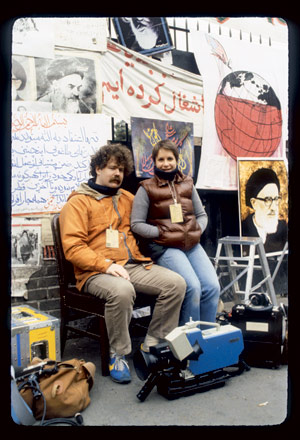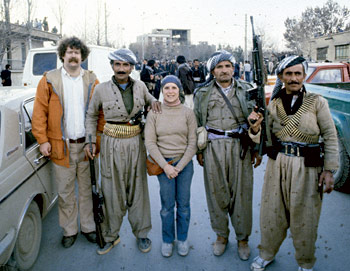What Steve and Martha Smith remember most vividly about a spring day in 1979 revolutionary Iran is not the bullets and violence but rather the woman with tea.
The Smiths, an American husband and wife camera crew on assignment for CBS, were getting footage of a firefight between Kurdish militants and Iranian government forces. Their attention shifted to a figure approaching them, walking only about 50 feet away from an active machine gun nest. It was a woman carrying a platter, upon which cups of tea rested steadily.
Steve and Martha Smith watched as this Kurdish angel of tea made her way to their resting spot. The Americans each accepted a cup, happily yet somewhat bashfully, in the way one does when confronted with an unexpected tea break during an armed rebellion. There are times even a firefight pauses for grace.
The unlikely tea incident happened on the Smiths’ first trip to Iran in 1979 to cover the revolution, in which Ayatollah Ruhollah Khomeini led an overthrow of the Shah Mohammed Reza Pahlavi. They were called back to Iran from Philadelphia in November after revolution supporters took over the American embassy in Tehran. They stayed for over a month.
The embassy takeover and subsequent hostage crisis returned to the American consciousness with last year’s release of “Argo,” a Ben Affleck-directed thriller that won three Academy Awards, including best picture. The Smiths, who now live near Kalispell, watched with great interest Affleck’s Hollywood reenactment of a time period that holds such meaning in their lives.
“Up until the ending, it felt very real,” Steve said recently from their home.
To avoid a spoiler for those who haven’t seen Argo, suffice it to say the movie takes creative liberties in its climactic scene. While there has been healthy debate over the rest of the movie’s historical accuracy, the Smiths say overall the film largely captures the feel of the moment, especially the street scenes.
Capturing the feel and scenes of the revolution was precisely what the Smiths were in Iran to do in 1979. Steve, who wielded the camera while Martha worked the audio, has footage from atop a building of thousands of demonstrators below lining the streets. He said when they saw his camera they immediately turned in hordes to face him and shout at the camera, knowing they were speaking to the world.
While they shot plenty of footage of the demonstrations and upheaval, there were other scenes that captured the Smiths’ imagination. As the world focused its attention on the U.S. embassy, where dozens of Americans had been taken hostage and outside of which demonstrators lined the streets, the Smiths tried to find out what was happening elsewhere in the country whenever their job duties didn’t require them to be at the heart of the demonstrations.
 |
|
Steve and Martha Smith are seen outside the American Embassy in Iran in 1979. | Photos courtesy of Steve Smith |
They filmed people going about their daily lives in parts of Tehran that seemed disconnected yet inescapably impacted by the revolution. For those who watched the chaos unfolding on the nightly news, where it may have seemed the whole country was in tumult, seeing the Smiths’ footage of the country’s quieter moments would come as a stark and perhaps surprising contrast.
“It was crazy because that was the real Tehran,” Martha said.
They both talked about the warm reception they would receive from Iranians away from the revolutionary hubbub. Some locals would want to practice their English or others would simply want to interact in some way. The Smiths traveled as much as they could and explored what Steve describes as a “beautiful country.”
“You could go out and walk around and nobody would mess with you,” Steve said.
Though they rarely felt in danger, the Smiths did run into a couple of unnerving situations, including one in which Steve’s journalistic tenacity nearly led to trouble. They had heard of some senior diplomats being held in a foreign ministry building, but upon arrival they were repeatedly shooed away by guards. So Steve decided to climb a wall. On top of the wall he heard a commotion and felt someone bang on his ankle. He had unwanted company.
 |
|
Steve Smith, left, and his wife Martha, center, stand with a group of Kurds in 1979 Iran while working for CBS. | Photos courtesy of Steve Smith |
“It turns out I had climbed the wall of army headquarters and those were army guys,” he recalled. “And they were not amused.”
What followed was a tense period in which the Smiths didn’t know if they were going to be detained indefinitely. They were finally released.
“When we got back to the hotel and told what had happened, the bureau chief said, ‘That’s terrible, now get your gear and go back to the embassy,’” Steve said. “And we did.”
The Smiths would go on to work for CBS for decades after their two Iran trips, traveling across the world, before moving to the Flathead from Philadelphia to seek a more laid-back lifestyle than overseas journalism. They opened and operated the Kalispell deli Gresko’s for years.
Yet of all their travels, the Iran assignments hold a special meaning for the Smiths. And with the turmoil of the modern Middle East and Iran, Martha said she’ll have to be content with the memories.
“You can’t go back now – the Middle East is too dangerous,” she said. “Iran was so interesting because it was so different. I really loved Iran.”